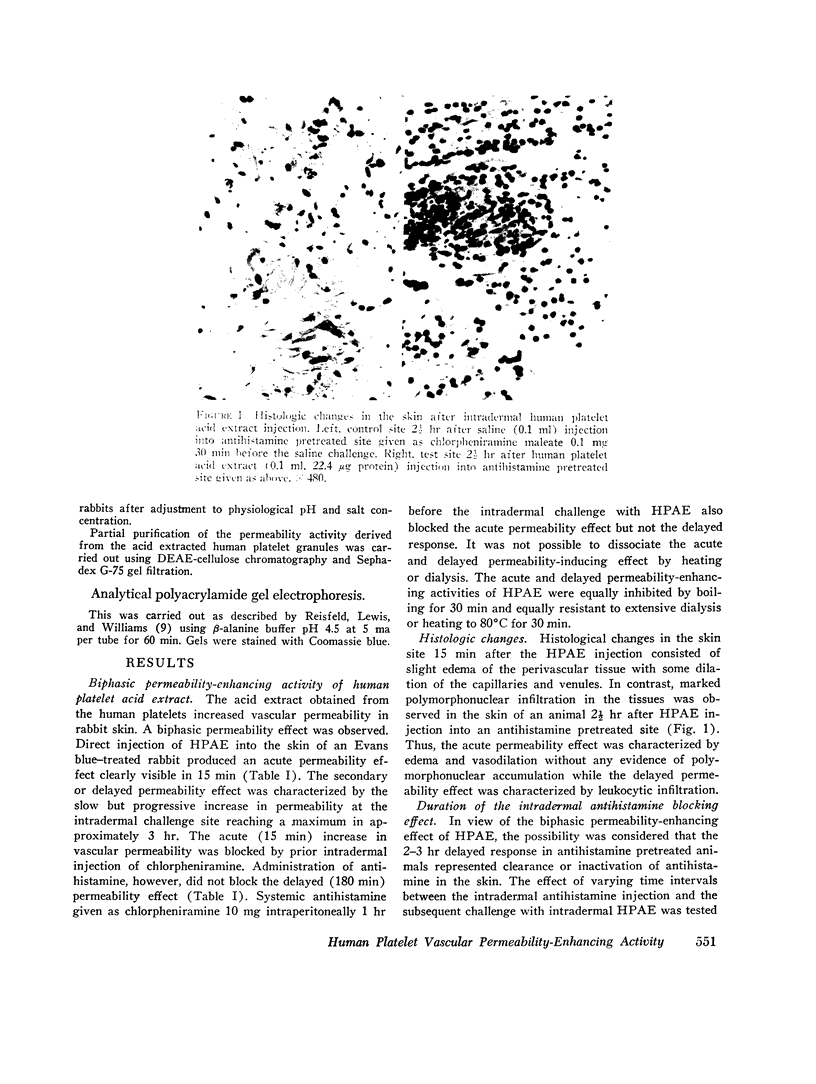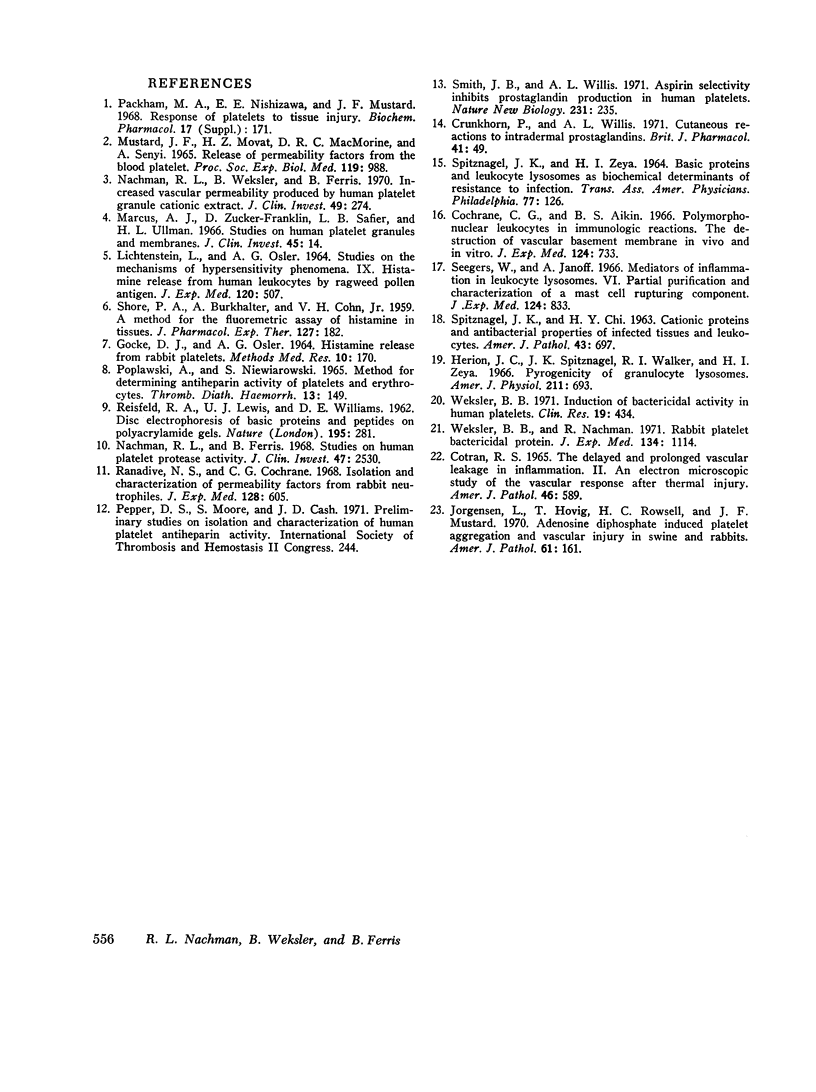Abstract
Human platelet acid extract obtained from both whole platelets and from isolated subcellular granules was partially purified by DEAE-cellulose chromatography and Sephadex gel filtration. The heat-stable, nondialyzable cationic protein fraction with a mol wt of approximately 30,000 produced a biphasic increase in vascular permeability in rabbit skin and also had antiheparin activity. The acute (15 min) increase in vascular permeability was blocked by prior treatment of the animal with antihistamine and was characterized histologically by edema of perivascular tissues and dilation of capillaries and veinules. The delayed (3 hr) permeability effect was not blocked by antihistamine and was characterized histologically by leukocytic infiltration into the skin. The experiments described suggest that human platelet lysosomal release of cationic proteins may increase vascular permeability by several mechanisms including endogenous histamine release as well as delayed chemotaxis.
Full text
PDF







Images in this article
Selected References
These references are in PubMed. This may not be the complete list of references from this article.
- COTRAN R. S. THE DELAYED AND PROLONGED VASCULAR LEAKAGE IN INFLAMMATION. II. AN ELECTRON MICROSCOPIC STUDY OF THE VASCULAR RESPONSE AFTER THERMAL INJURY. Am J Pathol. 1965 Apr;46:589–620. [PMC free article] [PubMed] [Google Scholar]
- Cochrane C. G., Aikin B. S. Polymorphonuclear leukocytes in immunologic reactions. The destruction of vascular basement membrane in vivo and in vitro. J Exp Med. 1966 Oct 1;124(4):733–752. doi: 10.1084/jem.124.4.733. [DOI] [PMC free article] [PubMed] [Google Scholar]
- Crunkhorn P., Willis A. L. Cutaneous reactions to intradermal prostaglandins. Br J Pharmacol. 1971 Jan;41(1):49–56. doi: 10.1111/j.1476-5381.1971.tb09934.x. [DOI] [PMC free article] [PubMed] [Google Scholar]
- GOCKE D. J., OSLER A. G. HISTAMINE RELEASE FROM RABBIT PLATELETS. Methods Med Res. 1964;10:170–172. [PubMed] [Google Scholar]
- Herion J. C., Spitznagel J. K., Walker R. I., Zeya H. I. Pyrogenicity of granulocyte lysosomes. Am J Physiol. 1966 Sep;211(3):693–698. doi: 10.1152/ajplegacy.1966.211.3.693. [DOI] [PubMed] [Google Scholar]
- Jorgensen L., Hovig T., Rowsell H. C., Mustard J. F. Adenosine diphosphate-induced platelet aggregation and vascular injury in swine and rabbits. Am J Pathol. 1970 Nov;61(2):161–176. [PMC free article] [PubMed] [Google Scholar]
- LICHTENSTEIN L. M., OSLER A. G. STUDIES ON THE MECHANISMS OF HYPERSENSITIVITY PHENOMENA. IX. HISTAMINE RELEASE FROM HUMAN LEUKOCYTES BY RAGWEED POLLEN ANTIGEN. J Exp Med. 1964 Oct 1;120:507–530. doi: 10.1084/jem.120.4.507. [DOI] [PMC free article] [PubMed] [Google Scholar]
- Marcus A. J., Zucker-Franklin D., Safier L. B., Ullman H. L. Studies on human platelet granules and membranes. J Clin Invest. 1966 Jan;45(1):14–28. doi: 10.1172/JCI105318. [DOI] [PMC free article] [PubMed] [Google Scholar]
- Mustard J. F., Movat H. Z., Macmorine D. R., Sényi A. Release of permeability factors from the blood platelet. Proc Soc Exp Biol Med. 1965 Aug-Sep;119(4):988–991. doi: 10.3181/00379727-119-30356. [DOI] [PubMed] [Google Scholar]
- Nachman R. L., Ferris B. Studies on human platelet protease activity. J Clin Invest. 1969 Nov;47(11):2530–2540. doi: 10.1172/JCI105935. [DOI] [PMC free article] [PubMed] [Google Scholar]
- Nachman R. L., Weksler B., Ferris B. Increased vascular permeability produced by human platelet granule cationic extract. J Clin Invest. 1970 Feb;49(2):274–281. doi: 10.1172/JCI106237. [DOI] [PMC free article] [PubMed] [Google Scholar]
- POPLAWSKI A., NIEWIAROWSKI S. METHOD FOR DETERMINING ANTIHEPARIN ACTIVITY OF PLATELETS AND ERYTHROCYTES. Thromb Diath Haemorrh. 1965 Mar 15;13:149–154. [PubMed] [Google Scholar]
- Packham M. A., Nishizawa E. E., Mustard J. F. Response of platelets to tissue injury. Biochem Pharmacol. 1968 Mar;(Suppl):171–184. doi: 10.1016/0006-2952(68)90304-3. [DOI] [PubMed] [Google Scholar]
- REISFELD R. A., LEWIS U. J., WILLIAMS D. E. Disk electrophoresis of basic proteins and peptides on polyacrylamide gels. Nature. 1962 Jul 21;195:281–283. doi: 10.1038/195281a0. [DOI] [PubMed] [Google Scholar]
- Ranadive N. S., Cochrane C. G. Isolation and characterization of permeability factors from rabbit neutrophils. J Exp Med. 1968 Oct 1;128(4):605–622. doi: 10.1084/jem.128.4.605. [DOI] [PMC free article] [PubMed] [Google Scholar]
- SHORE P. A., BURKHALTER A., COHN V. H., Jr A method for the fluorometric assay of histamine in tissues. J Pharmacol Exp Ther. 1959 Nov;127:182–186. [PubMed] [Google Scholar]
- SPITZNAGEL J. K., CHI H. Y. CATIONIC PROTEINS AND ANTIBACTERIAL PROPERTIES OF INFECTED TISSUES AND LEUKOCYTES. Am J Pathol. 1963 Oct;43:697–711. [PMC free article] [PubMed] [Google Scholar]
- SPITZNAGEL J. K., ZEYA H. I. BASIC PROTEINS AND LEUKOCYTE LYSOSOMES AS BIOCHEMICAL DETERMINANTS OF RESISTANCE TO INFECTION. Trans Assoc Am Physicians. 1964;77:126–134. [PubMed] [Google Scholar]
- Seegers W., Janoff A. Mediators of inflammation in leukocyte lysosomes. VI. Partial purification and characterization of a mast cell-rupturing component. J Exp Med. 1966 Nov 1;124(5):833–849. doi: 10.1084/jem.124.5.833. [DOI] [PMC free article] [PubMed] [Google Scholar]
- Smith J. B., Willis A. L. Aspirin selectively inhibits prostaglandin production in human platelets. Nat New Biol. 1971 Jun 23;231(25):235–237. doi: 10.1038/newbio231235a0. [DOI] [PubMed] [Google Scholar]
- Weksler B. B., Nachman R. L. Rabbit platelet bactericidal protein. J Exp Med. 1971 Nov 1;134(5):1114–1130. doi: 10.1084/jem.134.5.1114. [DOI] [PMC free article] [PubMed] [Google Scholar]








